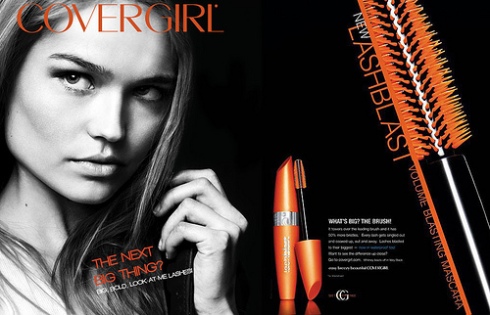I tired to think of all the common factors that successful ads have in common and after consideration, I realized that they all have a specific demographic. Nike, Adidas, Apple, all of these companies design their advertisements to appeal to young adults because they know we are easily influenced by the media to buy the newest gadgets. The media purposely adjusts their advertising strategies in order to grab the attention of the biggest fan bases they have.
The media grabs the attention of a specific audience by using interpellation – the process by which a person recognizes themselves with a particular identity. By looking at a particular ad, we can associate ourselves with the social roles being presented. The ad I found comes from a magazine, and interpellates to young females. The black and white photo in contrast to the bright neon orange was what initially drew me into the page and once I was pulled in, I had to keep looking. This is what the media wants. They want to pull in a certain demographic to get them engaged and interested. As a female, when I look at this ad, I see makeup and a pretty girl. I associate myself with the gender and social roles. This is demonstrated in the text stating, “To confirm this gender identity you probably adopted certain kinds of appropriate male and female behaviour. Simply being labelled as ‘boy’ or ‘girl’ may determine your behaviour to some extent” (p. 188). Since I associate myself with being a girl, this ad makes me believe that I need makeup and I need to look pretty. I am forced to abide by the certain roles presented in the ad because I recognize myself as the identity being portrayed, so I obviously need to look and act the same way.
Once the ad pulls us in, we’re forced to look closer and the phrase, “Big, bold, look at me lashes” can be clearly seen. This suggests that in order to be noticed, a woman must have full, voluminous lashes that men are attracted to. Upon reading this, many young girls probably feel that they need to go out and buy the makeup being advertised in order to fit the social roles that are associated with the identity they recognize themselves as. This idea is illustrated in the text on page 184 where the author proposes, “What this suggests is that our personality, our individual identity, and our subjectivity have been produced by a number of external factors.” If young girls look at this ad and feel like they need to buy the makeup in order to fit the social guidelines depicted, it soon leads them into believing that who they are is based on external factors, such as how they look. They associate their self-worth with how they look and this becomes very damaging for individuals.
Despite being harmful to self-esteem, this ad still initially grabbed my attention and made me want to buy the product. It uses contrasting images that pop out and intrigue me, and although I wish I wasn’t affected by the opinions of others, I am still conscious of what others think. This means that the idea of “big beautiful lashes” appeals to me. The media knows what consumers want and they build their advertisements to fit these wants. Even if a person does not want adjust their beliefs and values to match what the media tells them, it is inevitable that a person will be hailed in and eventually buy the product that a company is advertising.
Reference: O’Shaughnessy, M. and J. Stadler. Media and Society, Fifth Edition, Oxford University Press: Melbourne, 2012.
